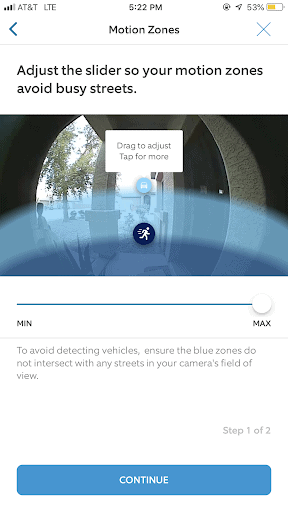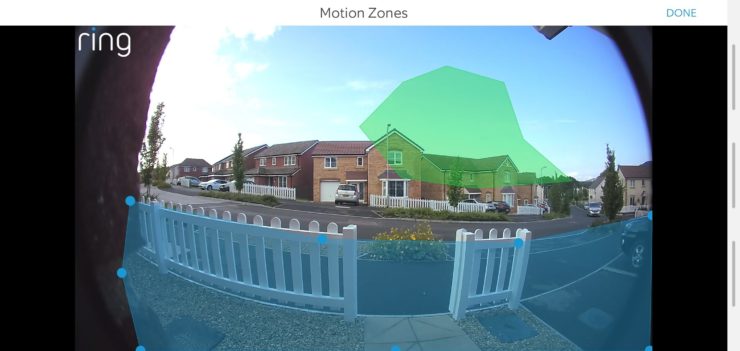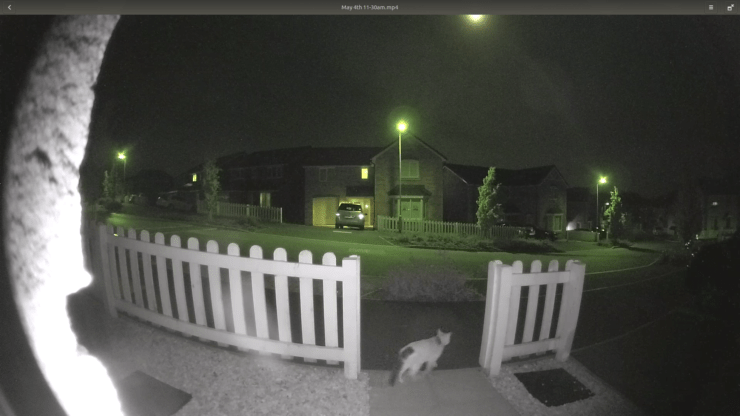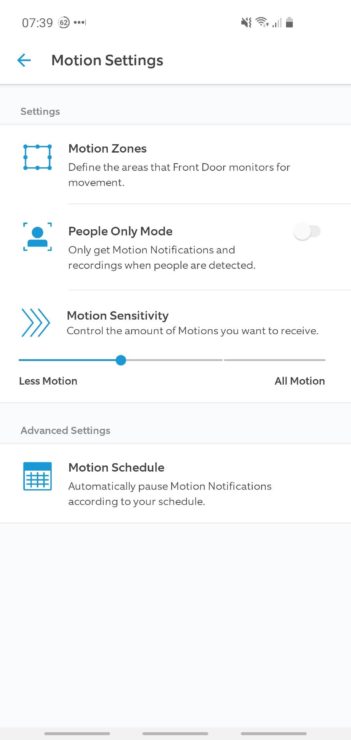Ring’s range of doorbells and cameras work by only recording when motion is detected (or the doorbell is pressed). This saves electric use or battery power, bringing down the costs of running your device. It also saves Ring money in cloud storage fees! But what happens if you live in an area with lots of animals?
Animals of all sizes – including tiny spiders – can set off Ring’s motion detection, triggering a recording and a notification to you. However Ring’s “People Only” mode can usually help solve this issue.
Recap: how Ring devices work

– shown by the blue ring.
Ring doorbells and cameras can either be battery operated, or hardwired (e.g. into the mains power of your house, or wired to a solar-capturing device which then powers your Ring camera).
Even though hardwired devices could record 24/7, since Ring store all clips in the cloud for a month (if you pay for the Ring Protect plan, that is), Ring only captures – and stores – recordings in a small number of cases:
- When motion is detected. This is the most common reason that Ring cameras will record, and will record around a minute of footage.
- When the doorbell is pressed. This naturally only applies to Ring’s range of smart doorbells, and will record around a minute of footage.
- When ‘Live View’ is activated. Using the Ring app (on a mobile or computer), you can go into each device and get a realtime view by enabling ‘Live View’ from the timeline. This will then record anything that is captured, until you cancel the live view (or up until a max of 10 minutes).
The way that motion detection is triggered also varies, depending on how your Ring device is powered. The two sections below cover this.
Ring’s motion detection in battery powered devices
Ring’s battery powered devices – whether they’re doorbells or cameras – must conserve battery power where possible. As a result, they have a fairly basic motion detection system: they use PIR (passive infrared sensors). In-fact they use three PIRs, similar to how outdoor lights (with motion detection) and alarm systems work.
These three fixed-location PIRs will scan different areas (left, center and right) and if a change to the infrared reading is detected – e.g. the heat from a human or animal is noticed – then the motion sensor will tell the Ring device to start recording.
This is why the motion detection customization on the Ring app allows you to customize motion detection via a slider which will ultimately give more priority to one of the three PIR sensors inside your Ring device:

Whilst this approach works fairly well – especially for a battery powered device – a big flaw is that it can’t work behind glass (such as windows). This is because the glass will stop any change in infrared reading, and this is why you’re recommended to only purchase a hardwired Ring device if you want to put your Ring camera behind a window.
Ring’s motion detection in hardwired models
This is where Ring’s motion detection is really powerful. You get ‘advanced motion detection’ capability, which is where you can draw multiple zones (different shapes) onto your Ring device’s view, and then only motion within these specific zones will trigger motion notifications:

This works by using pixel detection, instead of PIR sensors. In other words, since the Ring doorbell is hardwired, it’ll constantly be on and scanning for motion by actually recording. Now, these records aren’t sent up to Ring: they are simply very short video clips, which get binned if no motion is detected.
However by always taking very short clips, the Ring doorbell/camera can compare any possible motion within your specific motion zones, to work out whether or not valid motion has occurred. This is done on a pixel-by-pixel basis, by actually scanning for minor changes to the video capture.
This is a more versatile approach and – dare I say it – a smart approach, and motion detection behind windows works fine with these hardwired models.
How “People Only” mode can prevent animal detection
Right, that covers the recapping and background info parts! Let’s get onto the main question: how can we prevent being spammed with motion notifications, when it’s not even a person that’s triggering the motion?

As it happens, there is a simple option available to you here: “People Only Mode”:

You can get to this screen on a hardwired Ring device by:
- Clicking the device you want to change this setting on.
- Going to “Motion Settings”.
- Clicking the “People Only Mode” toggle.
On a battery powered device, this option instead exists under smart alerts:
- Click the device you want to change the setting on.
- Click “Smart Alerts”.
- Toggle the “People Only Mode” option.
What’s important to note here is that people only mode doesn’t stop recordings from occurring – it merely stops you receiving a notification if a person isn’t recognized. This means that if you get a lot of animal-based motion, your recordings list will still be massive – you just won’t get notifications for many of these recordings.
If – like me – your Ring device picks up a lot of motion (since the sidewalk is close to the front of my house), I turn off motion notifications altogether. As a result, ‘People Only mode’ wouldn’t benefit me.
Nonetheless, it’s a nice option for many people who only receive genuine motion notifications… or animals activating it by mistake!
This feature is available for people with a Ring Protect plan, or a hardwired device which was purchased before 30th September 2019.
The way this feature used to work for hardwired devices was that the device itself would scan any captured recordings, and try to work out whether the motion is a person or not.
This compares to battery powered devices which don’t have the power to work this out themselves, and instead they send the clip up to Ring’s cloud servers (as normal), and Ring’s more-powerful servers then make a judgement as to whether it’s a person or not.
However Ring saying that hardwired devices after October 2019 require a Ring Protect plan too (for people-only mode) suggests to me that newer hardwired devices also work the same way: i.e. they also send the recorded clip to Ring, and Ring’s servers now detect whether a person is present or not.
In some ways this makes sense, because it’s been rumored that Ring cameras used to use a third party bit of software for their motion detection, and this was removed when Amazon purchased Ring. Therefore it’s logical that Amazon/Ring have consolidated their motion-detection (and person-detection) software into a single point within Ring’s cloud servers, instead of having some Ring devices work out whether a person is present, and others sending the clip to Ring to work this out.
I digress a bit, but the main thing to know is that ‘People Only’ mode usually sends the entire recorded clip to Ring, and then Ring work out whether to notify you or not. This is why people only mode still records the clip – i.e. since it’s already been uploaded to Ring – and it’s only the notification which may or may not be sent to you.
Downsides of enabling “People Only” mode
Whilst “People Only mode” works fairly well overall, it does have some downsides:
- Some people have found that enabling it will mess up the ‘motion sensitivity’ settings, and lots of previous low-motion events (including animals!) now get recorded, sending you a notification in the process.
This seems to especially be the case in pre-October 2019 wired models that must still be performing on-device people recognition. This might be due to the aforementioned rumors that Amazon’s purchase of Ring led Ring to drop their third-party motion detection software, instead writing their own – resulting in some unreliable results when people only mode is enabled. - Following on from the above point, enabling people only mode actually sets motion sensitivity to 30% and then freezes it there. You can’t then change it. So if you find that you’re getting too many (or few) motion notifications, you can’t then change it.
- Just like animals can still get detected in ‘people only’ mode, it’s also possible for Ring to see a human face and mis-detect this, thinking it’s an animal and hence not notify you of this motion event. Yes it’ll still be recorded, but turning ‘people only mode’ on in this case will actually prevent a useful notification.

I use 7 (SEVEN!!!) Ring cameras specifically for WILDLIFE recording, but get vehicles as well. I’d love to be able to filter out vehicles, while still getting the rest of the motion.
Wow, that setup sounds awesome, I’m glad that 7 Ring cameras are working well for your wildlife recordings. But agreed – I’d love if Ring added vehicle-detection or exclusions. One of my Ring devices points near a road (I can’t position it any differently), and this seems like an overdue feature.